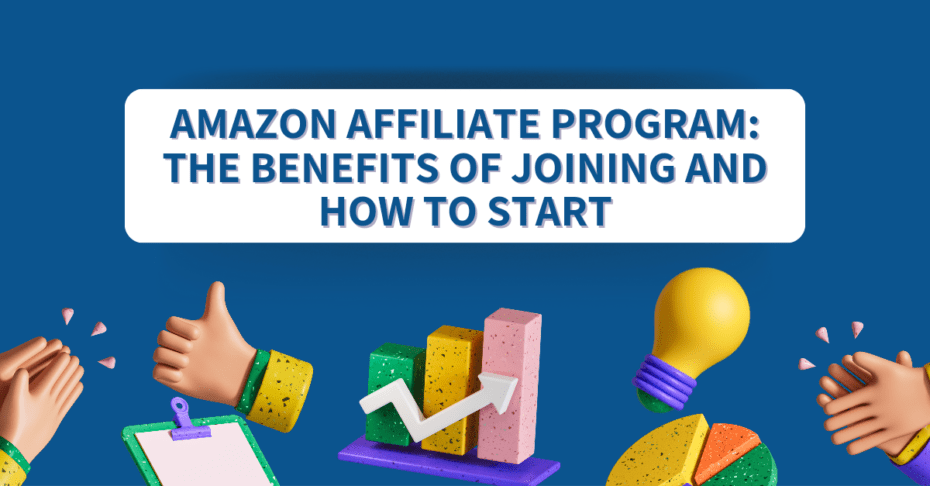The Amazon Affiliate Program, also known as Amazon Associates, stands out as one of the foremost affiliate marketing initiatives globally. It has provided countless content creators, bloggers, and marketers with opportunities to monetize their platforms and content.
But what exactly is this program, and how did it come into existence? Let’s delve into its intricacies and historical backdrop.
What is the Amazon Affiliate Program?
The Amazon Affiliate Program is an innovative and free-to-join system initiated by Amazon, the e-commerce behemoth. It allows individuals to promote any product from their vast inventory on their websites, blogs, or through social media channels. When visitors click on these affiliate links and make a purchase on Amazon, the affiliate earns a commission.
This commission varies based on the product category but can offer a lucrative means to generate income for many, especially those with a substantial online presence. In essence, it’s a win-win situation. Amazon gets more sales through the extended promotion by its affiliates, and in return, these affiliates get compensated for their promotional efforts.
Brief history and evolution of affiliate marketing with Amazon
Affiliate marketing is by no means a novel concept. It has been around since the early days of the internet. However, Amazon was among the pioneers to streamline and popularize it on a grand scale.
Launched in 1996, the Amazon Affiliate Program began at a time when Amazon was primarily a bookseller. The program’s inception was a game-changer, offering website owners a new revenue stream by promoting Amazon products.
As Amazon expanded its product range, venturing into electronics, apparel, home goods, and more, the Amazon Affiliate Program grew in tandem. The sheer diversity of products meant that affiliates from various niches could find relevant items to promote, amplifying the program’s appeal.
Furthermore, Amazon’s consistent focus on refining the program, introducing innovative tools for affiliates, and its unyielding commitment to customer service solidified its position at the forefront of affiliate marketing.
Over the years, while many other affiliate programs have come and gone, the Amazon Affiliate Program has remained strong, adapting to changing market dynamics and technological advancements, thereby ensuring its continued relevance in the ever-evolving digital marketing landscape.
Key Benefits of Joining the Amazon Affiliate Program
Joining the Amazon Affiliate Program offers a myriad of benefits that are hard to overlook. Aspiring affiliates, bloggers, and content creators often find themselves drawn to this program, not merely because of Amazon’s formidable market presence, but also due to the tangible advantages it provides.
Let’s unravel these benefits one by one, shedding light on why the Amazon Affiliate Program remains an attractive proposition for many.
A vast product range to promote
One of the standout features of the Amazon Affiliate Program is the sheer breadth of products available for promotion. Whether you run a tech blog, a fashion vlog, or even a niche website about gardening, Amazon’s vast inventory ensures you’ll always find products relevant to your audience.
This flexibility means you’re not confined to a single product category, allowing for dynamic content that caters to diverse segments of your audience. As the website’s product offerings continue to grow, so do the opportunities for affiliates to diversify their promotional strategies, making the Amazon Affiliate Program a constantly evolving platform for income generation.
Trustworthy reputation of Amazon
The name “Amazon” carries with it a level of trust and recognition that few other online entities can claim. When affiliates promote products from Amazon, they’re leveraging this trust. Visitors are often more inclined to click on an affiliate link when they recognize it leads to a reputable source like Amazon. This trust factor can significantly enhance conversion rates, leading to more successful affiliate campaigns.
Competitive commission structures
While the Amazon Affiliate Program might not always offer the highest commissions in the market, its structure is competitive, especially considering the volume of sales Amazon generates.
Affiliates can earn commissions ranging from a few percentages to more substantial figures, depending on the product category. And given the high conversion rates often associated with Amazon, these commissions can accumulate rapidly, making it lucrative for dedicated affiliates.
User-friendly tools and resources for affiliates
Navigating the world of affiliate marketing can be daunting, especially for newcomers. Amazon recognizes this and offers an array of tools and resources to aid affiliates.
From easy-to-use link-building tools to detailed analytics reports, the Amazon Affiliate Program ensures that affiliates, whether seasoned or beginners, have the resources they need to run successful campaigns.
Additionally, the program periodically offers webinars, tutorials, and articles, ensuring affiliates are up-to-date with best practices and new features.
Global reach and potential for passive income
Amazon’s global presence is undeniable. With dedicated marketplaces in numerous countries, the potential for affiliates to tap into international markets is vast. This global reach ensures that your affiliate links have relevance beyond your immediate geographical location.
Moreover, once these affiliate links are set up on your website or content platform, they can generate passive income. As visitors continue to interact with your content and make purchases through your affiliate links, you earn commissions. Over time, with consistent effort, this can evolve into a significant revenue stream, with the potential for both short-term and long-term gains.
How to Get Started with the Amazon Affiliate Program
The allure of the Amazon Affiliate Program is undeniable. With its promise of passive income and the backing of a global e-commerce powerhouse, many aspire to tap into its potential. However, as with all ventures, the beginning can feel overwhelming.
Fear not! Embarking on this journey is relatively straightforward. Let’s walk through the steps you need to take to launch your Amazon affiliate marketing adventure.
Meeting the basic prerequisites
Before diving headfirst into the world of Amazon affiliate marketing, there are some fundamental prerequisites you should meet.
Firstly, you should have an established online platform, be it a blog, website, YouTube channel, or even a robust social media presence. This will be your primary tool in promoting Amazon products.
Next, it’s essential to have a clear content strategy or niche. Amazon affiliates find the most success when they cater to specific audience interests, offering product recommendations that resonate with their readers or viewers.
And of course, being familiar with the basic guidelines of the Amazon Affiliate Program ensures that you maintain good standing and don’t inadvertently run afoul of their terms.
Registering and setting up your Amazon Associates account
Initiating your journey with the Amazon Affiliate Program begins with the registration process. Head over to the Amazon Associates homepage and click on ‘Join Now for Free’. Here, you can either log in with your existing Amazon account or create a new one.
The setup process involves several steps, including providing details about your website or platform, choosing your preferred store ID (usually related to your website name), and describing your platform’s primary purpose.
Amazon will also ask about your promotional methods and traffic sources. It’s essential to be honest and detailed in this section, as it gives Amazon a clearer picture of how you intend to promote their products.
Upon completion, you’ll receive your unique Amazon Associates ID, marking your official entry into the program.
Navigating through the Amazon Affiliate dashboard
Once registered, the Amazon Affiliate dashboard will be your primary hub for all affiliate activities. The dashboard offers insights into your performance metrics, earnings, and conversion rates. For newcomers, it might seem a bit overwhelming, but with time, its intuitive design becomes evident.
At the dashboard’s heart is the ‘Product Linking’ section, where you can search for Amazon products and generate affiliate links. There’s also the ‘Reports’ section, giving you a detailed breakdown of clicks, sales, and revenue. Regularly visiting this dashboard and understanding its various features will ensure you can optimize your strategies for better results.
Selecting the right products to promote
Choosing the right products is the linchpin of a successful Amazon affiliate venture. Given Amazon’s vast product range, this might feel like finding a needle in a haystack. But remember your niche and audience preferences.
Use the dashboard’s search functionality to identify products that align with your content. Consider promoting products you have personal experience with or those with high ratings and reviews.
Moreover, keep abreast of Amazon’s best sellers and new arrivals. These can offer insights into trending products that might resonate with your audience. By marrying your audience’s interests with the right products, you set the stage for a successful affiliate marketing journey with Amazon.
Tips for Maximizing Earnings from the Amazon Affiliate Program
Earning through the Amazon Affiliate Program is an exciting prospect, but like any venture, the difference between success and mediocrity often hinges on the fine details.
While joining the program and promoting products is a start, to truly maximize your earnings, there are specific strategies and nuances you should be aware of. Here, we’ll delve into these tactics, ensuring that your affiliate marketing efforts yield the best possible results.
Understanding Amazon’s commission structure
At the core of your earnings as an Amazon affiliate is the commission structure. It’s essential to recognize that not all products yield the same commissions. Rates can vary based on product categories, and sometimes, promotions or seasonal changes can influence these rates.
Being aware of which product categories offer higher commissions can guide your promotional strategy. For instance, luxury beauty products might fetch a higher commission rate than home goods. Therefore, if you have a platform that can cater to both niches, prioritizing the promotion of luxury beauty products can be more lucrative.
Additionally, keeping an eye on Amazon’s official communication regarding commission rates can help you adapt to any changes and ensure you’re always aligned with the most profitable product categories.
Implementing SEO strategies for affiliate content
SEO, or Search Engine Optimization, is the art of making your content discoverable on search engines. As an Amazon affiliate, driving organic traffic to your content can significantly boost conversions. This is because users who find your content through a search query are often actively looking for information or products, making them more likely to click on affiliate links.
To enhance your content’s SEO, conduct keyword research to identify terms your target audience might search for. Incorporate these keywords naturally into your content, titles, and meta descriptions. Ensure your website is mobile-friendly, has a good loading speed, and provides value to visitors.
Backlinks, which are incoming links from other reputable websites, can also boost your site’s authority and SEO rankings. Remember, the more visible your content is on search engines, the more traffic and potential conversions you can achieve.
Using Amazon Native Shopping Ads for better conversions
Amazon Native Shopping Ads are akin to ad placements that can be incorporated into your website or platform. Unlike traditional banner ads, these are dynamic and display products based on your content and visitors’ browsing habits. The result? Highly relevant product ads that resonate with your audience’s current interests.
Implementing Native Shopping Ads can significantly enhance your conversion rates. They seamlessly integrate into your platform, offering product suggestions that are both contextual and timely. Plus, given their dynamic nature, these ads can cater to a broad segment of your audience, increasing the chances of clicks and subsequent purchases.
Monitoring and analyzing performance metrics
The Amazon Affiliate dashboard isn’t just a place to generate product links; it’s a goldmine of data. Regularly monitoring and analyzing this data can offer insights into what’s working and what isn’t. Look at metrics like click-through rates, conversion rates, and overall earnings.
Identify which products or product categories are your top performers and consider doubling down on them. Conversely, if some links or products aren’t converting well, it might be time to reevaluate their placement or even consider alternative products to promote. Periodic analysis allows for iterative improvements, ensuring your affiliate marketing strategy is always optimized for maximum earnings.
Potential Challenges and Considerations in the Amazon Affiliate Program
The allure of the Amazon Affiliate Program is undeniable. Yet, like all ventures, it isn’t free from challenges. To truly thrive and sustain success within this program, it’s essential to be aware of and address these potential hurdles.
Not only will this awareness help you navigate issues more effectively, but it also empowers you to create a more robust and resilient affiliate marketing strategy.
Staying compliant with Amazon’s terms of service
One of the most pressing challenges affiliates face in the Amazon Affiliate Program is staying compliant with Amazon’s continually evolving terms of service. Amazon is known for its stringent rules, and even inadvertent violations can lead to account suspensions.
For instance, mentioning product prices (which fluctuate and may not always be accurate) or using Amazon’s user reviews without permission can land you in hot water.
It’s imperative, then, to periodically review Amazon’s terms of service. Set aside time, perhaps monthly or quarterly, to go through any updates or changes. This proactive approach ensures that you’re always aligned with Amazon’s requirements, minimizing the risk of unintentional rule breaches.
The impact of short cookie duration
The “cookie duration” in the Amazon Affiliate Program is a mere 24 hours. This means that if a visitor clicks on your affiliate link and doesn’t make a purchase within a day, you won’t earn a commission on any subsequent purchase. This short window can impact potential earnings, especially when promoting high-value items that customers might take longer to decide on.
To mitigate this, focus on creating compelling content that drives immediate action. Product reviews, comparison articles, or limited-time deal alerts related to the Amazon Affiliate Program can create a sense of urgency in the reader, nudging them to make quicker purchase decisions.
Dealing with potential account terminations
Perhaps one of the most daunting challenges in the Amazon Affiliate Program is the threat of account terminations. Amazon is proactive in ensuring the integrity of its affiliate ecosystem and won’t hesitate to terminate accounts that violate its terms.
If you face account termination, the first step is to understand the reason. Amazon typically provides a rationale for its decision. Once you’re clear on the violation, take corrective action. If it’s a content issue on your website or platform, address it promptly.
If you believe there’s been a misunderstanding, consider reaching out to Amazon’s support to seek clarification or redress. Keeping thorough records of your affiliate activities can also be invaluable in such situations, offering evidence in case of disputes.
Remember, while the potential challenges in the Amazon Affiliate Program are real, they are navigable with the right approach and mindset. Stay informed, be proactive, and always prioritize the best interests of your audience, and you’ll find the path to success smoother than anticipated.
Conclusion: Is the Amazon Affiliate Program Right for You?
Venturing into the world of affiliate marketing, especially with a behemoth like Amazon, can feel like standing at the edge of an expansive forest, unsure of what lies within.
On one hand, there’s the undeniable allure of passive income and the promise of flexibility; on the other, the concerns of navigating Amazon’s intricate rules and the competitive landscape. So, how does one decide if the Amazon Affiliate Program is the right path?
Weighing the pros and cons
Like any significant decision, it’s essential to weigh the advantages against the potential pitfalls. The Amazon Affiliate Program offers vast product diversity, a trusted brand name, and user-friendly tools for affiliates. These strengths can make it easier for newcomers to find their footing and for seasoned affiliates to expand their repertoire.
However, the challenges are just as real. From the stringent terms of service to the brief cookie duration, there’s a learning curve to mastering the Amazon Affiliate Program. Then there’s the question of competition. With many affiliates promoting similar products, setting yourself apart requires creativity, dedication, and a genuine understanding of your target audience’s needs.
In essence, the Amazon Affiliate Program might be right for you if you’re willing to invest the time to understand its nuances, continuously adapt to its changing landscape, and are committed to offering genuine value to your audience.
Best practices for long-term success with the Amazon Affiliate Program
Success in the Amazon Affiliate Program isn’t just about joining and promoting products; it’s about embracing practices that foster long-term growth. Here are some tailored insights for those aspiring for longevity in the program:
- Audience First: Always prioritize your audience’s needs. Authenticity matters, and readers or viewers can sense when recommendations are forced. Promote products you believe in and that align with your platform’s niche.
- Continuous Learning: The digital landscape is ever-evolving, and so is the Amazon Affiliate Program. Commit to regular learning, be it understanding Amazon’s latest policies or grasping new SEO strategies.
- Diversify Promotion Strategies: Relying solely on one form of content or promotion can be limiting. Consider diversifying by exploring video content, email marketing, or even podcasts related to the products you’re promoting through the Amazon Affiliate Program.
- Engage and Interact: Engaging with your audience boosts trust. Respond to comments, engage on social media, and always be open to feedback. This not only builds a loyal audience base but can also provide insights into what they want, guiding your future promotional efforts.
In summary, the Amazon Affiliate Program offers a plethora of opportunities, but it’s not a one-size-fits-all solution. It demands diligence, adaptability, and a commitment to authenticity. If you resonate with these values and are prepared for the journey, the Amazon Affiliate Program might just be the next big step in your digital marketing adventure.






